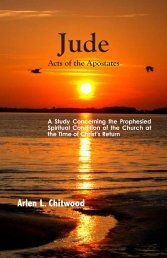Signs in John's Gospel - The Lamp Broadcast
Signs in John's Gospel - The Lamp Broadcast
Signs in John's Gospel - The Lamp Broadcast
Create successful ePaper yourself
Turn your PDF publications into a flip-book with our unique Google optimized e-Paper software.
<strong>The</strong> Resurrection of Christ 197<br />
<strong>The</strong> expression “after three days,” relative to Christ’s resurrection,<br />
is found only two places <strong>in</strong> the N.T. [Matt. 27:63; Mark 8:31]; and, as<br />
previously seen, Matt. 12:40 reveals the same period of time to also be<br />
“three days and three nights.”<br />
Also note the expression “<strong>in</strong> [or, ‘with<strong>in</strong>’] three days,” perta<strong>in</strong><strong>in</strong>g<br />
to Christ’s resurrection [Mark. 14:58; 15:29; John 2:19, 20].<br />
<strong>The</strong> Jewish Talmud reads, “A day and night together make up an<br />
onah [word referr<strong>in</strong>g to a complete period of twenty-four hours], and<br />
any part of such a period is counted as the whole.” <strong>The</strong> Jewish Talmud<br />
though, at this po<strong>in</strong>t, is simply a reflection of that taught <strong>in</strong> the O.T.,<br />
which is the only possible source to derive <strong>in</strong>formation which will allow<br />
one to properly understand and reconcile the expressions <strong>in</strong> the<br />
N.T. relative to the time Christ spent <strong>in</strong> the place of death — three days<br />
and three nights <strong>in</strong> the tomb, raised on the third day, raised after three days.<br />
One must allow Scripture to <strong>in</strong>terpret itself at this po<strong>in</strong>t — or any<br />
other place <strong>in</strong> Scripture — rather than br<strong>in</strong>g<strong>in</strong>g man’s ideologies or his<br />
Western way of th<strong>in</strong>k<strong>in</strong>g over <strong>in</strong>to the matter [cf. Gen. 40:13, 20; 42:17,<br />
18; I Sam. 30:1, 12, 13; II Chron. 10:5, 12; Esther 4:16-5:1].)<br />
Thus, hav<strong>in</strong>g completed the time necessary to rema<strong>in</strong> <strong>in</strong> the<br />
place of death at the beg<strong>in</strong>n<strong>in</strong>g of the third day, there would have<br />
been no need for Christ to rema<strong>in</strong> <strong>in</strong> this place longer than time<br />
immediately follow<strong>in</strong>g the Sabbath, time immediately follow<strong>in</strong>g<br />
6 PM. But, aga<strong>in</strong>, the exact tim<strong>in</strong>g of His resurrection <strong>in</strong> this respect<br />
is not given. We can only know that His resurrection had<br />
already occurred prior to the time Mary Magdalene and other<br />
women came to the tomb, found the stone cover<strong>in</strong>g the tomb<br />
rolled away, and the tomb empty except for the graveclothes.<br />
And the stone had not been rolled away to let Christ out of<br />
the tomb, as was the case with the resurrection of Lazarus <strong>in</strong> the<br />
previous sign. Rather, the stone had been rolled away to let others<br />
<strong>in</strong> to see that He was already out.<br />
Christ’s resurrection was unlike anyth<strong>in</strong>g which had ever occurred<br />
<strong>in</strong> the annals of man’s recorded history. A Man had not<br />
only been raised from the dead by the triune Godhead, but He,<br />
as part of the triune Godhead, had raised Himself — someth<strong>in</strong>g<br />
which He had to have a part <strong>in</strong>, for He was “the resurrection, and<br />
the life” (cf. John 2:18-21; 11:25; Acts 3:15; Rom. 8:11).



